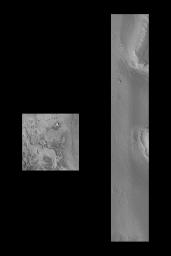
|
Medusae Fossae Formation
- Click the image above for a larger view
- Full-Res JPEG (1536 x 2304) (242.0 kB)
- Full-Res TIFF (1536 x 2304) (1.0 MB)
Caption:
An exotic terrain of wind-eroded ridges and residual smooth surfaces are seen in one of the highest resolution images ever taken of Mars from orbit. The Medusae Fossae formation is believed to be formed of the fragmental ejecta of huge explosive volcanic eruptions. When subjected to intense wind-blasting over hundreds of millions of years, this material erodes easily once the uppermost tougher crust is breached. In the Mars Orbiter Camera (MOC) image shown on the right, the crust, or cap rock, can be seen in the upper right part of the picture. The finely-spaced ridges are similar to features on Earth called yardangs, which are formed by intense winds plucking individual grains from, and by wind-driven sand blasting particles off, sedimentary deposits.
The MOC image was taken on October 30, 1997 at 11:05 AM PST, shortly after the Mars Global Surveyor spacecraft's 31st closest approach to Mars. The image covers an area 3.6 X 21.5 km (2.2 X 13.4 miles) at 3.6 m (12 feet) per picture element--craters only 11 m (36 feet, about the size of a swimming pool) across can be seen. The context image (left; the best Viking view of the area; VO 1 387S34) has a resolution of 240 m/pixel, or 67 times lower resolution than the MOC frame.
Background Info:
Malin Space Science Systems (MSSS) and the California Institute of Technology built the MOC using spare hardware from the Mars Observer mission. MSSS operates the camera from its facilities in San Diego, CA. The Jet Propulsion Laboratory's Mars Surveyor Operations Project operates the Mars Global Surveyor spacecraft with its industrial partner, Lockheed Martin Astronautics, from facilities in Pasadena, CA and Denver, CO.
Cataloging Keywords:
| Name | Value | Additional Values |
|---|---|---|
| Target | Mars | |
| System | ||
| Target Type | Planet | |
| Mission | Mars Global Surveyor (MGS) | Viking |
| Instrument Host | Mars Global Surveyor | |
| Host Type | Orbiter | |
| Instrument | Mars Orbiter Camera (MOC) | |
| Detector | ||
| Extra Keywords | Crater, Dust, Grayscale, Volcano | |
| Acquisition Date | ||
| Release Date | 1998-02-12 | |
| Date in Caption | 1997-10-30 | |
| Image Credit | NASA/JPL/Malin Space Science Systems | |
| Source | photojournal.jpl.nasa.gov/catalog/PIA01159 | |
| Identifier | PIA01159 | |
